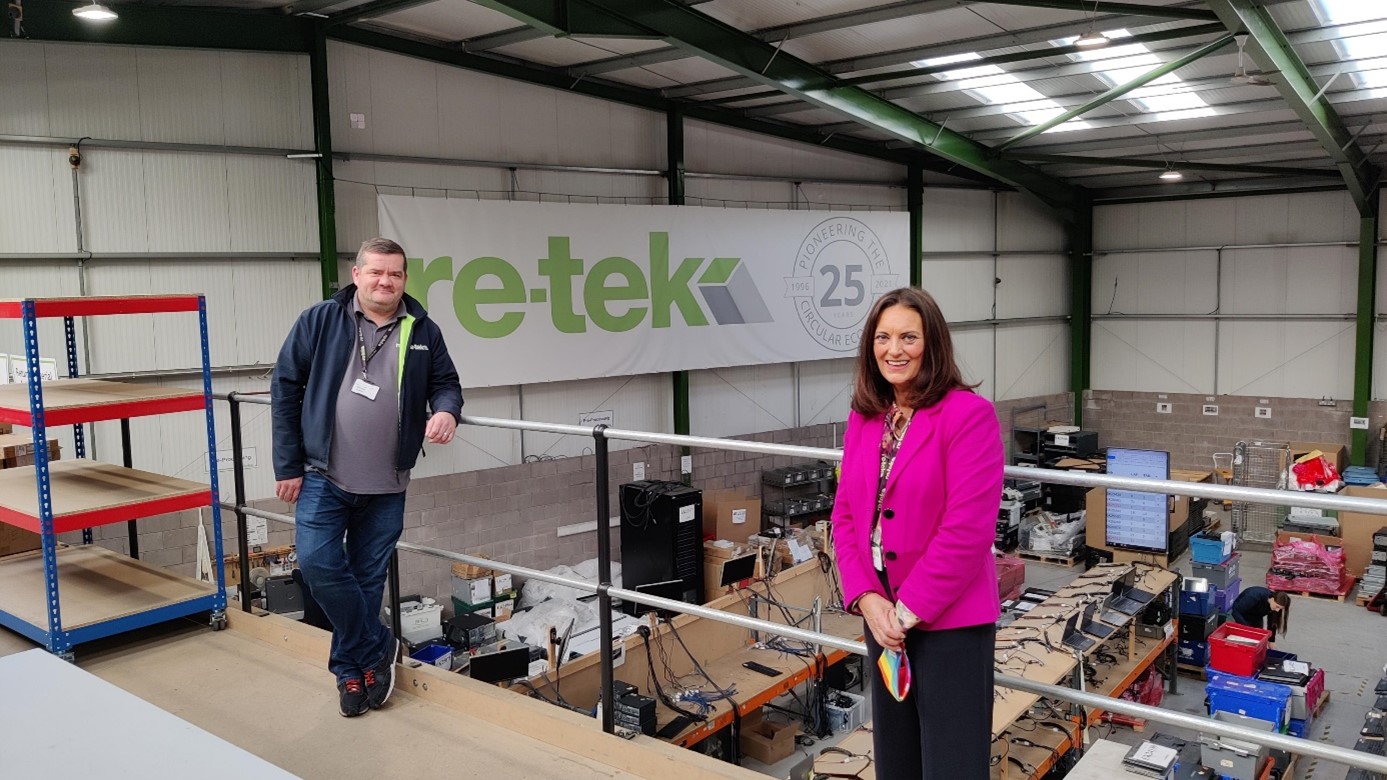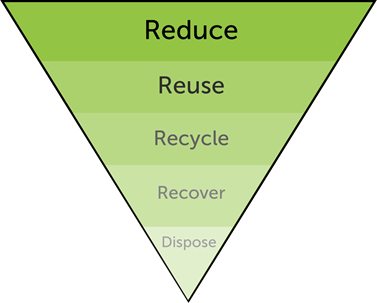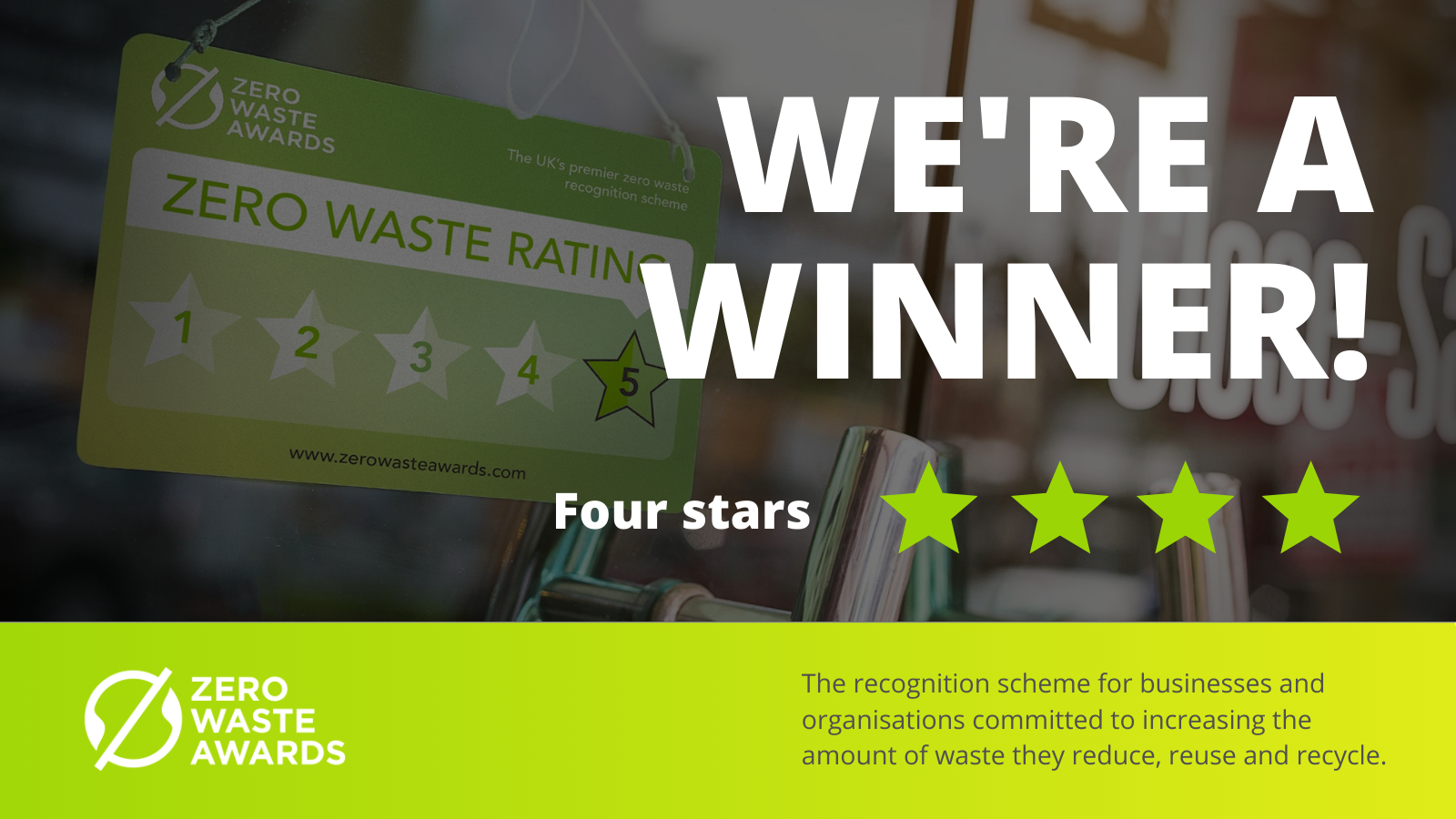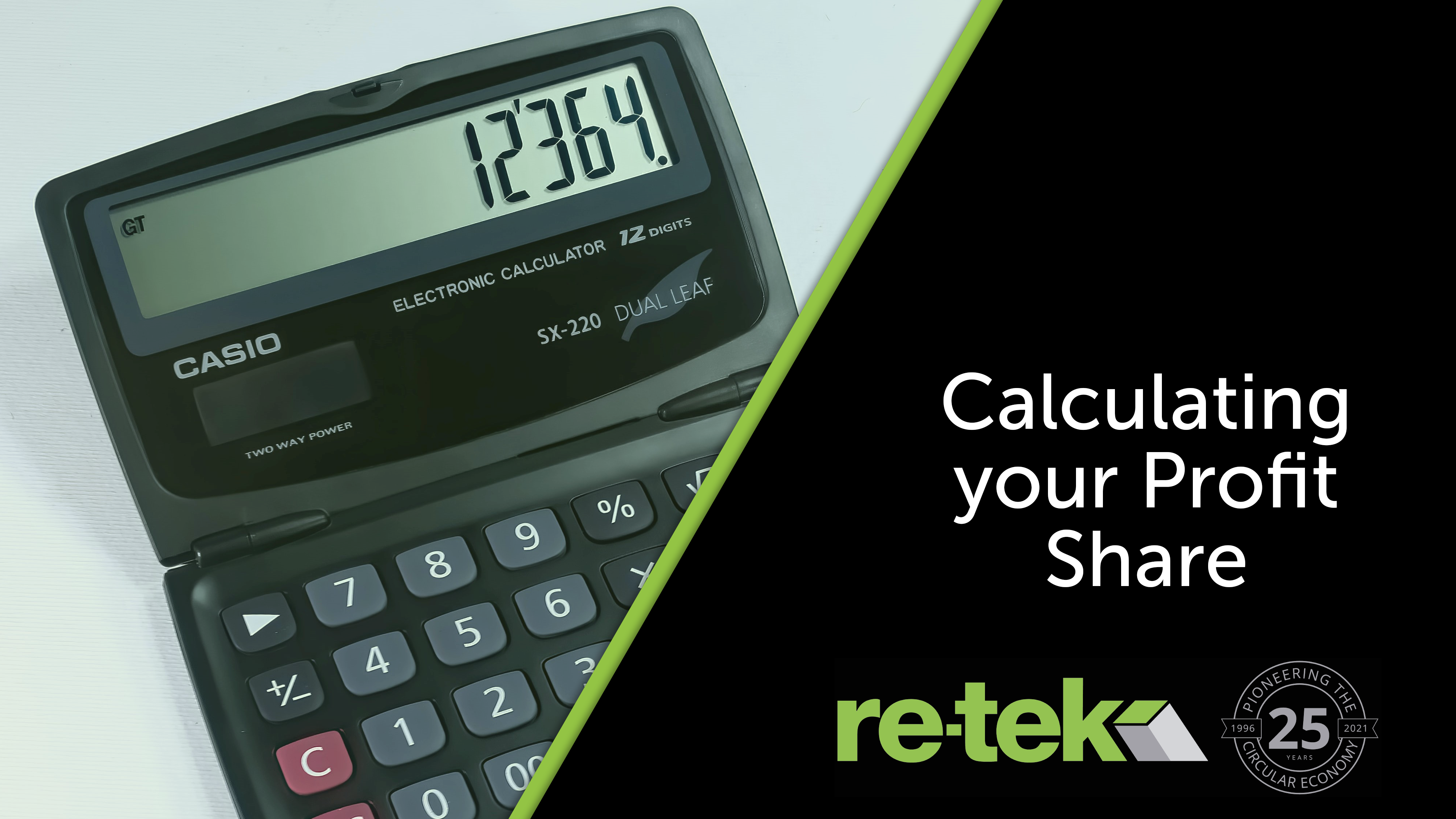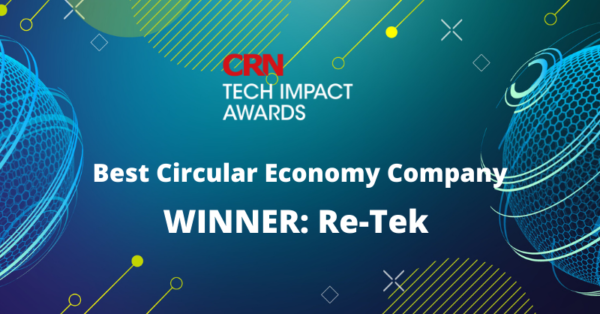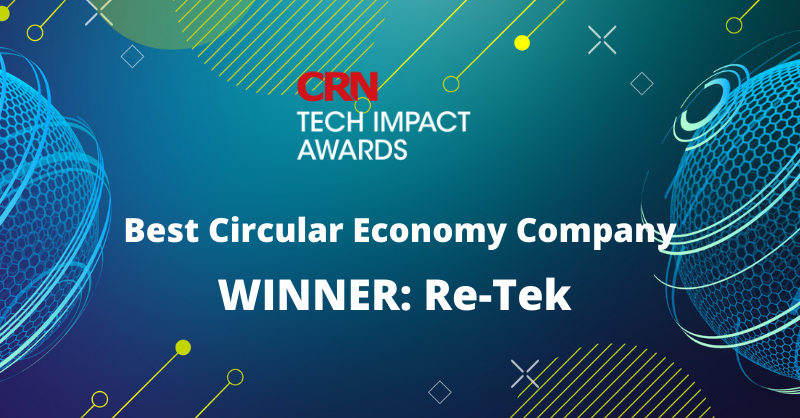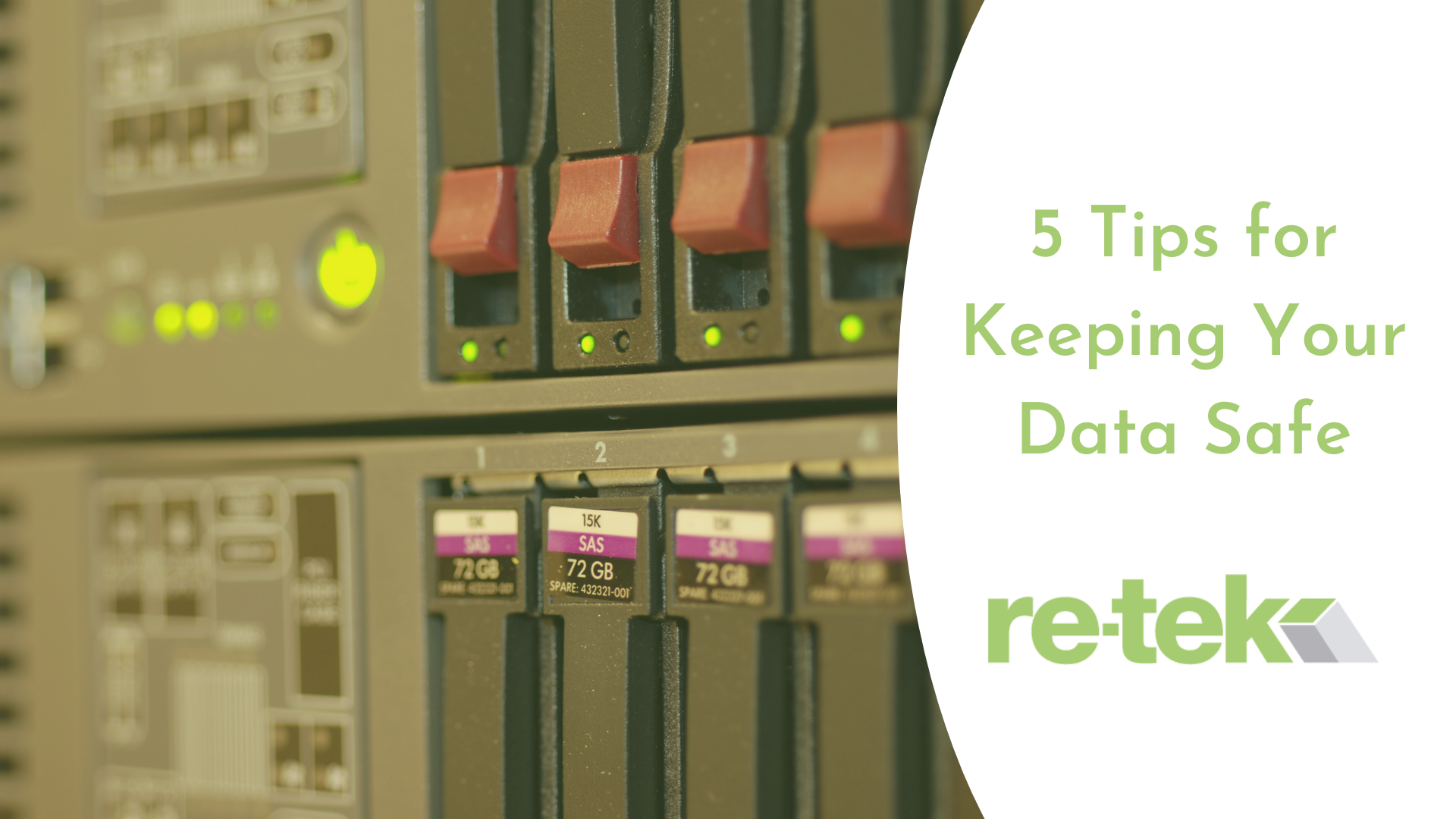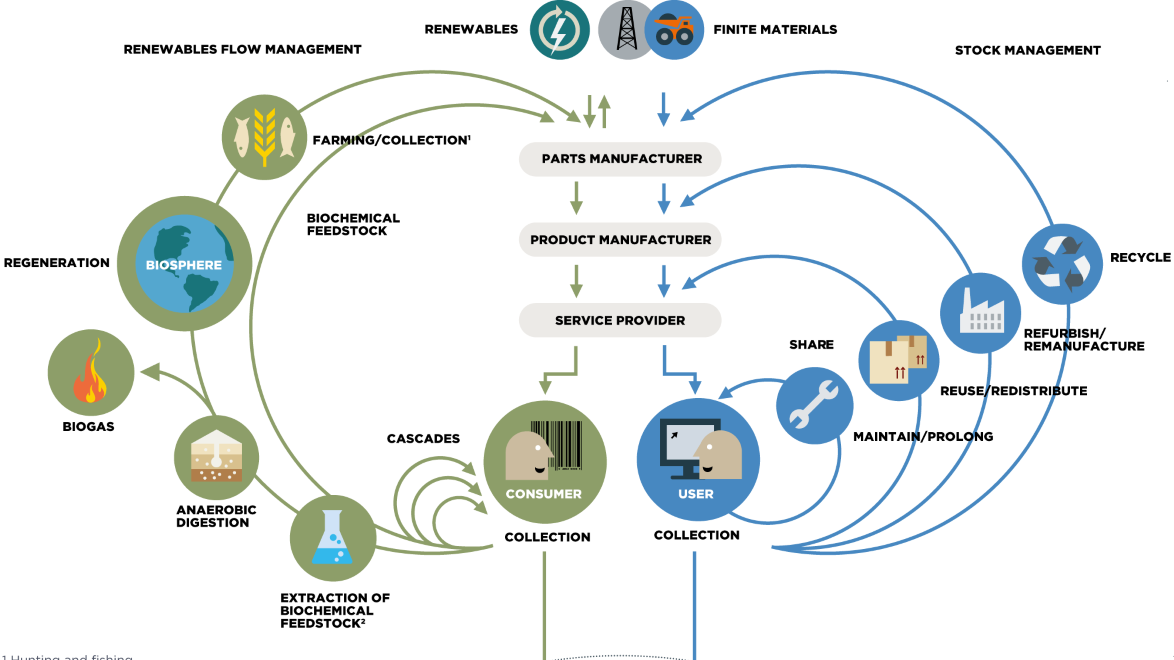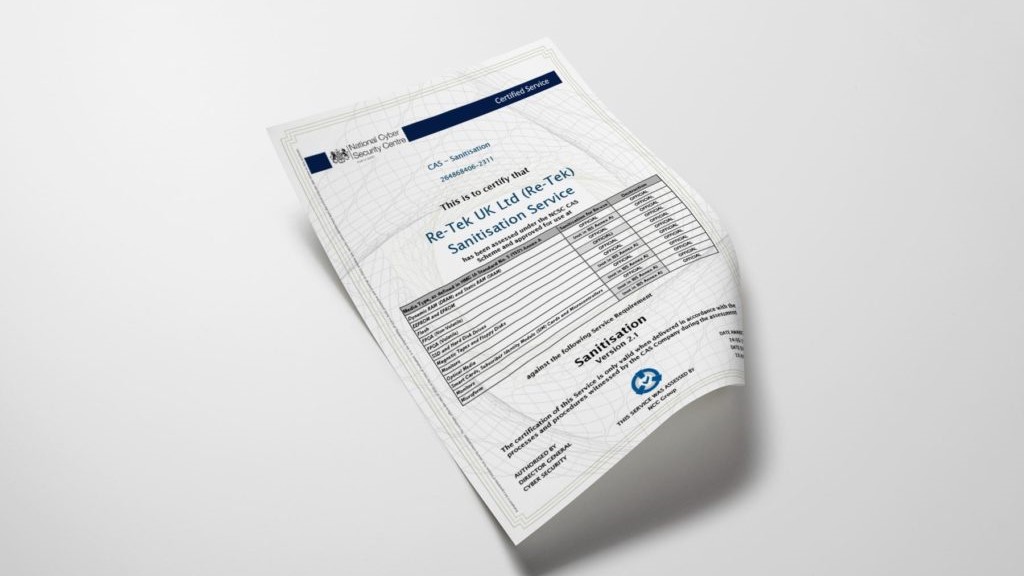Local MSP visits Award-Winning IT Disposal Company
Local MSP visits Award-Winning IT Disposal Company
Re-Tek (UK) welcome Collette Stevenson, MSP for East Kilbride, to their state of the art IT disposal facility.
Showcasing East Kilbride Business
Re-Tek (UK) Ltd are a growing business in the East Kilbride community. Situated in the Kelvin South Business Park, Re-Tek are a member of a strong business network in the area. As supporters of South Lanarkshire’s ‘Routes to Work’ programme, Re-Tek have provided employment for the long-term unemployed in East Kilbride. Re-Tek’s Managing Director, Gordon Lowrie, spoke with Collette about Re-Tek’s focus on good working conditions and local recruitment.
A Tour of the Facility
Ms. Stevenson was given a tour of Re-Tek’s facility by Gordon Lowrie, the managing director. The visit took place on Wednesday the 20th October, just two weeks before the start of COP26. The tour highlighted Re-Tek’s continued investments in renewables and energy efficiency. Additionally, Re-Tek were able to showcase their custom-built volume build centre, which has allowed to business to expand their service offering. Re-Tek’s project director, William McPherson, explained Re-Tek’s ‘cradle-to-grave’ model, which allows the business to sustainably handle IT equipment throughout from deployment to disposal.
“We were delighted to welcome Collette to our facility today. Collette was very engaged with our sustainability messaging and provided us with some useful insights from a government perspective. We were able to have a stimulating conversation around green issues and the best methods for tackling them.” – Gordon Lowrie, Managing Director
Going Over the Government's Green Goals
Ms Stevenson was able to provide some insight into the government’s environmental strategy. The Scottish government has made significant changes to tackle climate change head on. Re-Tek were able to better understand the government’s sustainability goals. Similarly, Re-Tek provided Ms Stevenson with a better understanding of how IT Asset Disposal can help in the fight against climate change.
“It was great to visit Re-Tek and meet Gordon Lowrie and employees who talked through the work they do. Their commitment to renewable energy is impressive, and it was great to see how their operations make a positive impact in the fight against climate change. They’ve gone from strength to strength over the years and I have no doubt their success will continue long into the future.” – Collette Stevenson, MSP East Kilbride
Anticipation Builds for COP26
Re-Tek extended an invitation to Ms Stevenson for their upcoming sustainability webinar, ‘“Closing the Loop” in ICT’. The event, which takes place during COP26, will discuss the circular economy in the UK economy. Invites have also been sent to Ms Stevenson’s peers on the Net Zero, Energy, and Transport Committee.
Recent News
Re-Tek's Revenue Share Model: How is it calculated?
Re-Tek's Revenue Share Model: How is it calculated?
Looking to dispose of your IT but don't know how much it's worth? Re-Tek will give you an insight into how we calculate how much money you get back.
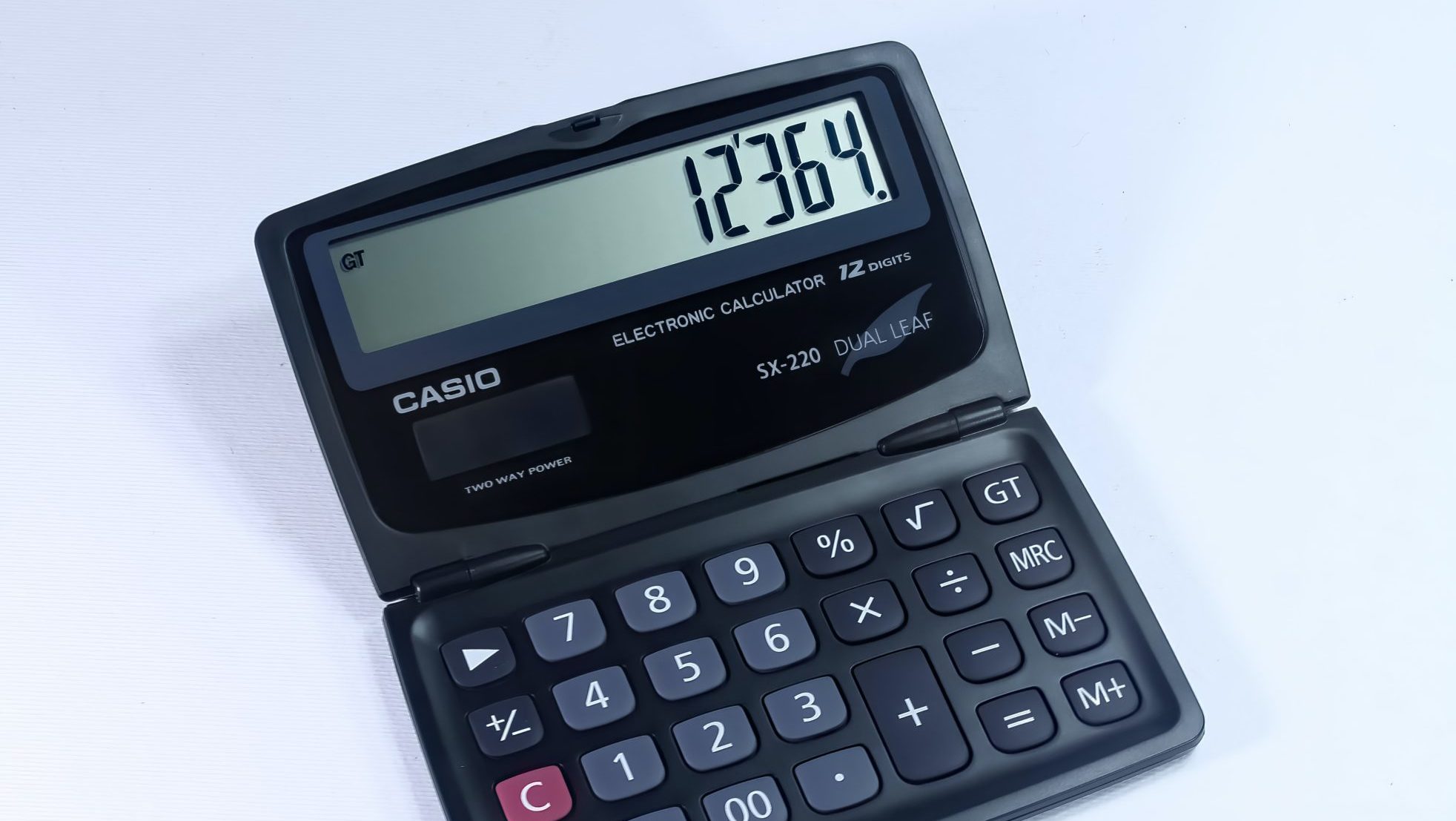
What is a Revenue Share Model?
A revenue share model allows you to get a cut of the profits that Re-Tek make. Why? Because it is important that you are rewarded for taking the right steps to becoming more sustainable.
Re-Tek are able to provide some financial return on most IT disposals. It all depends on our operating costs and the value of the used IT.
What is the Re-Tek Formula?
Step 1
First, Re-Tek will look through and note everything we have collected from your business. We put this into our bespoke database which creates an asset management form.
Step 2
From there, our re-marketing team will assess the devices including their condition. With over 10 years of experience in the industry, they can tell instantly what has value and what doesn’t. But we don’t work on instinct alone. So, our re-marketing team will check the pricing with our network of buyers to make sure it is correct.
Step 3
Re-Tek then work out the operational costs for the job. This includes transportation costs, working hours, and energy use. This is taken off of the sale value.
Step 4
Then, Re-Tek are able to offer you a financial return on your IT equipment. This will be a 70/30 profit split. From there, you can use your share for whatever you would like. Don’t know what to spend it on? We have a few ideas that businesses like yours are using.
What should I do with the money?
You have several options when you receive your quote. Some businesses decide to use their money themselves while others will donate it to charity. How do you know which is right for your business?
Subsidise your IT Refresh
If you are disposing of redundant IT, you are likely buying new equipment. Use the money generated by your old IT to cover some of that cost. You can therefore lower the lifetime cost of your IT.
Make a Donation to Charity
Does your company have an associated charity or foundation? Re-Tek are able to donate to a charity of your choice. Turn your redundant IT into a force for good. You can use these funds to boost your corporate social responsibility.
Add Funds to Another Budget
Do you have departments crying out for bigger budgets? Give them some extra finances from your waste IT. This could give your marketing an extra boost or could buy some extra equipment for your warehouse team.
Recent News
Re-Tek Continue Pioneering the Circular Economy with Momentous Award Win
Re-Tek Continue Pioneering the Circular Economy with Momentous Award Win
Re-Tek UK are proud to share that we have won the inaugural “Best Circular Economy Company” award at the CRN UK Tech Impact Awards.
A Big Night For Sustainable IT
Thursday the 16th September saw many of the IT channel’s most sustainable businesses come together for the inaugural Tech Impact Awards. Run by CRN, these awards celebrated the efforts of IT channel partners becoming more environmentally friendly.
Re-Tek the Night's Biggest Winners
There was stiff competition for the “Best Circular Economy Company” Award, with industry giants HP and Computacenter both nominated. However, Re-Tek pulled off the upset by picking up the award. In a category of 14 strong competitors, Re-Tek were delighted to come out on top.
Why did Re-Tek win "Best Circular Economy Company"?
Re-Tek’s continued efforts to develop and drive forward the circular economy have resulted in the receipt of this award. Judges were impressed by Re-Tek’s commitment to renewable power which allows the business to offset the carbon emissions of their customers. Re-Tek’s innovative processes for extracting critical raw materials was more important however. Re-Tek have taken steps towards saving key materials such as gold, cobalt, and tantalum.
“A huge congratulations and thanks goes out to all of our team for their hard work and dedication in helping us become a leading and trusted partner, pioneering the Circular Economy and driving the industry forwards.” – Gordon Lowrie, Managing Director
What's Next for Re-Tek following this award?
Re-Tek will continue to offer best in class re-manufacturing and re-use services to our customers. We are innovating our processes to ensure that we offer cost-effective and secure IT lifecycle services to our partners. Re-Tek are committed to lowering our carbon footprint, and we are looking into new ways to achieve net carbon zero.
“The accelerating worldwide focus on carbon reduction means that the likelihood of many of these recognised initiatives will become an expected standard in our industry in the future where we will continue to invest in progressing and disrupting standard practice therefore reducing the impact technology has on our environment” – Kevin Culligan, Chairman and Co-Founder.
Recent News
How much Carbon does your IT really emit? A Brief Explanation of Embodied Carbon
How much Carbon does your IT really emit? A Brief Explanation of Embodied Carbon.
The embodied carbon of your electronic equipment is the sum total of the energy required to manufacture a product. You can better understand the full environmental impact of your purchases by understanding this. Below, you can find out how embodied carbon can be calculated and what it means for the environment.

A Lifetime of Carbon Emissions
When talking about the environmental impact of our daily commute, we only talk about the carbon emitted from our car’s exhaust pipe. Likewise, we talk about how the switch to electric cars would reduce the carbon emissions from our commute. However, this only takes into account the operational carbon emissions from the fuel used to power our cars. We don’t consider the carbon emissions from the manufacturing plants for both types of car. And what about the energy needed to mine and refine the raw materials? This is what we call embodied carbon. This can alter the way we think about the environmental impact of our purchases.
What is Embodied Carbon?
Embodied Carbon, sometimes known as Embedded Carbon, is a calculation of the carbon emissions from the manufacturing process. Ultimately, this means that there are other factors to the carbon emissions that come from your purchases. For example, the amount of tantalum required for 1,000 printed circuit boards creates 301.6kg of greenhouse gases (CO2-eq). Each of these printed circuit boards would be used in a PC, which adds to the carbon footprint of the final product. Therefore, the full environmental impact of your PC goes beyond its energy use. If you sum together the footprint of each component, you will have the material footprint of one PC. Multiply this out for a suite of 2,000 PCs and laptops and you can begin the see the full impact of your IT suite on the environment. Is there a way to limit this environmental impact?
How we can Harness Embodied Carbon
Once a PC or laptop has been manufactured and distributed, the majority of its carbon footprint has already been accounted for. This is the energy from the material mining, the manufacturing process, and the delivery to your facility. You begin to add to that material footprint through the energy required to run them. Many companies have realised that they can lower their operational carbon emissions by making some key changes. These changes include using renewable energy or switching machines off when not in use.
However, you can still make the most of the energy used to manufacture the product. You can do this by re-using the product itself or any of its composite parts. This gives these materials a second lease of life and reduces the material footprint of new products. Additionally, using second-hand IT lowers the material footprint of your IT estate as these products have an extended lifetime.
Calculating the Embodied Carbon of your IT
Calculating the total embodied carbon of a PC or laptop is not easy. Due to the number of different materials and components in these devices, keeping track of the carbon emissions for everything can be tricky. Therefore, getting the most accurate result would require a database of each different element with their specific carbon footprint. However, this would be very difficult to achieve. Alternatively, manufacturers will provide a breakdown of the key carbon footprint of each aspect of a PC. For example, the table below shows the values for a Dell Optilex 7760 All-in-One Desktop:

From this, you can calculate that the Dell Optilex 7760 All-in-One has an embodied carbon of 446.4kg CO2-eq. Over the course of a typical 4-year lifecycle, this accounts for around 62% of the total carbon footprint of the product with the remainder coming from the use of the product. Carbon footprint assessments for other Dell products can be found here.
A Little Perspective
200 Dell Optilex 7760s would create the same amount of carbon emissions as a full Boeing-747 travelling from London to New York over a 4-year lifetime.
Improving the Carbon Footprint of your IT
With this knowledge of the material footprint of your IT, you can begin to lower the environmental impact of your IT estate. Firstly, by extending the use period of these devices you could lower the overall impact of a PC or laptop. This is because over half of the carbon footprint of a device comes from the initial manufacturing rather than the use. This means that switching to renewable energy only tackles a small proportion of the problem. Extending the lifecycle of these PCs would flip this on its head. Using a PC over a period of 8 years would cause approximately 1,000 kg CO2-eq compared to using a PC over 4 years causing 720 kg CO2-eq.
A Better Way to Track the Material Footprint
Keeping track of the carbon footprint of a device over its lifetime remains difficult. This is particularly true when the product has been repaired using new components. Introducing a Digital Product Passport could be the solution to this problem. This would create a centralised bank of information for each device. This information would include the carbon footprint of each component within the device. By using this technology, you would be able to understand the full extent of the embodied carbon in your devices at the touch of a button.
Choosing an ITAD: 6 Tips to Help you Make the Right Choice
6 Tips for Choosing the Right ITAD Partner
Are you upgrading your IT and thinking “what do I do with my old IT equipment”? Or do you have old IT taking up valuable space as you move back into the office? A quick Google search will produce a long list of IT Asset Disposal (ITAD) companies ready to take control of your end-of-life IT. But how do you know which of them to trust? What makes one ITAD better than another?
Your IT holds valuable, confidential information about your business, your employees, and your customers. Ensuring that it is disposed of through the right channels is vital. Keeping your data secure is essential and failure to do so can have some severe consequences. That makes choosing the right partner to dispose of your old IT a difficult choice. Make sure that you are making an informed choice by following these simple steps.
What is an ITAD?
Before we dive into picking an ITAD partner, we need to know what an ITAD is. ITAD stands for Information Technology Asset Disposal. Simply put, ITAD is the process of disposing of your IT equipment in a secure and environmentally safe way. While you may have processes in place to protect your data on your servers, it is just as important to protect your end-of-life assets. Therefore, ITAD firms are the final line of defence for your IT equipment and your cybersecurity.
ITAD companies have several processes for disposing of your IT assets. ITAD firms provide solutions for hard drive shredding, recycling in line with the WEEE directive, and secure data erasure, helping businesses when they upgrade their IT suite by providing a secure channel to dispose of their IT.
When choosing to trust a new partner to manage your IT Assets and Confidential Data, you face a dilemma. How do you know you’re making the right decision? What criteria, industry guidance or performance measures do you work from, to ensure your decision is solid?
Tips for what to look out for when choosing an ITAD partner are:
- Accreditations
- Expertise
- Price
- Environmental Policy
- Traceability and Transparency
- Security Practices
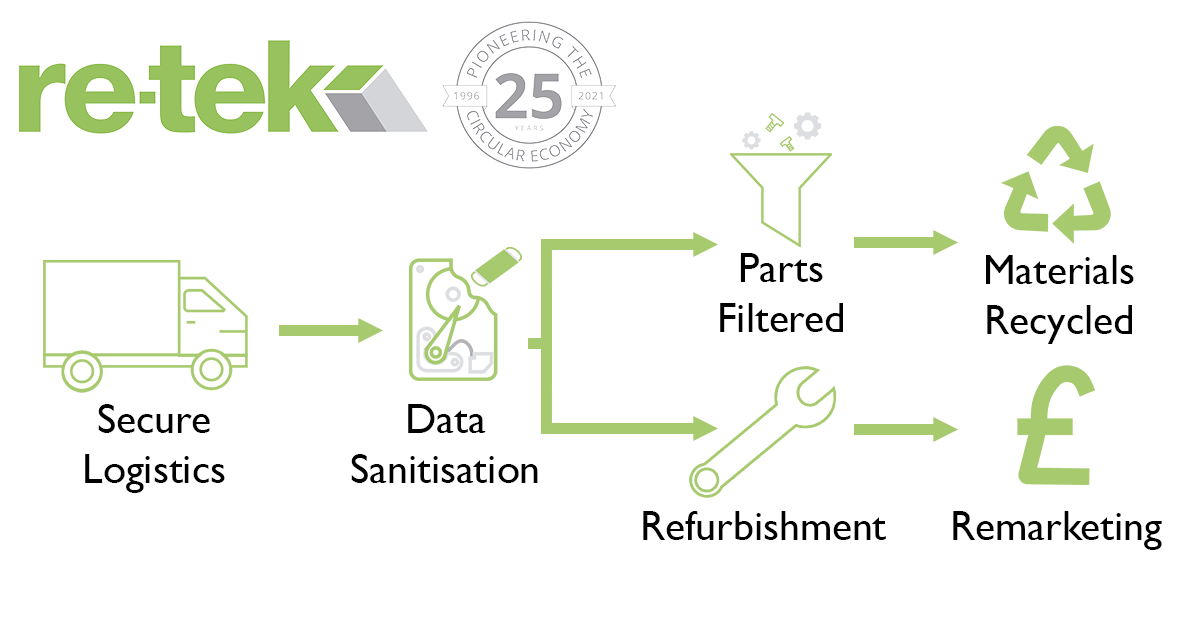
Tips for Finding the Right IT Disposal Partner
Before we dive into picking an ITAD partner, we need to know what it is. ITAD stands for Information Technology Asset Disposal. Simply put, ITAD is the process of disposing of your IT equipment in a secure and environmentally safe way. ITAD firms will take your end-of-life IT and ensure that it is safely disposed of.
ITAD companies have several processes for disposing of your IT assets. ITAD firms provide solutions for hard drive shredding, recycling in line with the WEEE directive, and secure data erasure. ITAD companies help businesses when they upgrade their IT suite by providing a secure channel to dispose of their IT.
Accreditation
One of the first things that you want to know about an ITAD partner is if they have the relevant accreditations. These accreditations mean that the ITAD firm has been audited and vetted to meet industry standards set by experts.
Here is a list of some of the key accreditations to look out for:
- ISO 9001 – setting out the criteria for a quality management system. This includes a focus on the customer and internal audit processes for continual improvement.
- ISO 27001 – this standard sets out the processes for managing information security. As disposal companies deal with your confidential data, it is essential that they have this accreditation.
- Blancco partner – Blancco is the market-leading data erasure software and is approved by the National Cyber Security Centre. Ensure that your ITAD partner is using this best-in-class software.
These accreditations give you peace of mind that your partner is up to the highest standard. Make sure that these are still up to date and are visible on their website to give yourself peace of mind that you are working with an expert.
Expertise
On top of having all the relevant certifications, you can trust an ITAD firm that has years of expertise under their belt. Companies with a long history in the industry will have better connections for reselling your IT equipment, more efficient processes for collecting and disposing of your IT and have a superior understanding of your needs. Remember, there is a reason that these companies have been around for so long. You should be aware of the company’s track record, if there is any uncertainty you should avoid these companies. Moreover, you should ensure that your ITAD partner can provide you with certifications on the topics of erasure and recycling electronic devices securely.
Governmental regulations are constantly changing, so make sure you are working with an ITAD that has a strong knowledge of the market and who remains aware of these changes as they happen.
Price and Financial Rebate
Make sure that you unlock the value in your end-of-life IT. Most of your IT equipment will have re-sale value in the secondary market. Any ITAD firm worth their weight will have a financial rebate policy whereby they will return some of their profit back to you.
Additionally, some firms will offer you the opportunity to donate your old IT equipment to a charity or organisation of your choice. These services allow you to improve your corporate social responsibility practices using assets you already own. Building your corporate image can become even easier as ITADs take care of every step, from collection of your assets, to delivering them to the organisation of your choice.
Zero Waste to Landfill
Environmental reporting is one of the most important aspects of modern business. Working with a partner that understands the importance of this is therefore essential. Choose an ITAD company that follows a zero-landfill policy. This gives you peace of mind that your waste IT has been recycled properly in line with the WEEE directive.
Transparency
To guarantee that your IT is being handled as you expect it to be, make sure that your ITAD partner is transparent about their practices. This means making sure that you have access to a suite of reporting to follow the full chain-of-custody of your data-bearing assets.
Security Practices
Ensuring that every step throughout the ITAD process is fully documented with certificates for both the destruction and wiping of drives helps to maintain security throughout your supply chain. Be aware of the software being used by your ITAD. The company should be using highly credible software such as the world leading Blancco overwriting software.
Remember that your end-of-life IT houses valuable data for your business. Therefore, you should choose a partner that follows strict security practices throughout the process. This could include having unmarked, GPS-tracked vehicles that collect your assets to ensure they are safe at all times. It could also include having secure holding facilities for your assets prior to the data wiping process. Think about what level of security you expect with your current IT assets and make sure that your ITAD partner aligns with those standards.
Why is it important to get it right?
It is important to choose the right ITAD partner for your company as you do not want any of your secure data to get leaked or not processed in the correct format. You want to be confident that your ITAD partner can provide you with the exact processes and audit trails that your equipment has went through until the end process e.g., re-used, recycled etc.
If your data is not disposed of through the proper channels, it could cost you £17.5 million or 4% of your annual turnover. Not to mention that your reputation as a credible brand could be tarnished following one of these incidents. Ensuring that your data is disposed of correctly is key to keeping your business safe.
Why choose Re-Tek?
At Re-Tek Limited we provide a wide portfolio of offerings to our customers. As previously stated, we have all of the main, important accreditations that allow us to do our work securely and effectively, which is GDPR aligning. Services that we offer include:
- Secure data erasure
- IT asset re-sale and reporting
- WEEE Recycling, which is wiped to NCSC standards
- Secure Shredding
- Decommissioning
5 Tips for Keeping your Data Secure
5 Tips for Keeping your Data Secure
Step 1: Ensure that your data is kept under lock and key
Strong Passwords Make Strong Defences
The key to keeping your data safe is making sure that it does not fall into the wrong hands. A strong password is the first step when it comes to stopping people from stealing your confidential information. If your password is not strong enough, hackers can easily get into your system to steal your personal data. Make sure that your passwords are changed regularly to keep your systems safe.
How do hackers get into your system?
There are several methods that hackers will use to try and access your system. Understanding these methods will help you to protect against them. This will give you an insight into what the main threats are to your cyber security.
- Brute Force Attacking – Hackers will try to crack your password by guessing. They will therefore try generic passwords first to try and gain access to your system. Examples of generic passwords include ‘Password1’ or passwords that contain personal information, such as your name or your company. Most of these attacks use automated processes to attempt different combinations of words and numbers. Ensure that your passwords are difficult to guess to keep your data safe.
- Dictionary Attack – This is very similar to a brute force attack as hackers will try to guess your password. However, instead of trying common passwords, they try a much larger selection of words. Effectively, hackers will run a system which tries random combinations of common words or phrases. Therefore, passwords with common phrases are high risk. Make sure that your passwords are unique so that they are much harder to crack.
- Phishing Scams – The most common type of cyber-attack, phishing scams usually take the form of emails sent to employees. This usually involves an unverified link or document. These links typically contain malware which will infect your system. Clicking on a link or document gives hackers a backdoor entrance to your internal systems and data.
What Makes a Password Strong?
In order to keep your data safe from hackers, it is essential that your employees use strong passwords. Since hackers will often try a series of common words and phrases, passwords should not be overly simple. This means making sure that passwords contain a mixture of upper- and lower-case letters, numbers, and symbols. This will protect you against the two most common types of attacks: brute force and dictionary attacks. Encourage your employees to set longer passwords as these are much harder to crack. Have an internal password policy to ensure that everyone is setting strong passwords.
Take Extra Precautions
Adding an extra step to your security process can save your data. Where possible, use two-factor authentication. Most services offer this as standard, including Google and Microsoft. It works by sending a text to your personal mobile when a new device signs into your account. Two-factor authentication means that even if hackers manage to crack your password, they will not be able to access your private information. Use password managers to avoid data leaks. Password managers allow you to use much stronger passwords without having to remember them. Once you log in to a password manager, you will have access to all of your passwords for your websites and subscriptions. Most password managers will provide suggestions for strong passwords when you sign up to a new website. Google has now built this into their service which helps improve your cyber security.
Step 2: Train Your Staff to Understand Cyber Threats
Train Your Staff to Stop Data Leakage
Your employees are most at risk of giving away sensitive information about your company. Proper training is key to stopping your employees from leaking your data. Ensuring that everyone at your company understands the threats to your cyber security is therefore vital. Make sure to train your employees throughout the year. In particular, make sure your employees are aware of any new cyber threats as they are uncovered. This could include new phishing scams which are one of the biggest threats to the security of your data.
What is a phishing email?
All companies will have to face phishing emails on an almost daily basis. Here are some of the warning signs to look out for:
- Abnormal email addresses – Avoid clicking on any links from unfamiliar email domains. If you do not recognize the sender, do not open the link. An unfamiliar email domain is the biggest red flag that you have received a phishing email.
- Spelling and Grammar Mistakes – Be aware of emails that contain typos or poor grammar. If an email seems to come from a reputable company but is littered with these errors, it is likely a phishing email. Additionally, be conscious of the formatting used in the email. If you receive an email that differs from emails you have previously received from a company, report it to your IT manager. Hackers will likely slip up in this area and follow a different style to the company they are impersonating.
- Strange Openers – Most of the time emails will open with a personalized greeting when sent to your private email. For example, most emails will begin “Good Morning Mr Smith” or “Hello John”. Typically, phishing emails will be sent to a large database of people. This means that emails will not be personalized to you. Therefore, if an email begins with a more generic greeting, be wary. Avoid clicking on links in emails that begin “Dear Sir/Madam” unless you recognize and trust the email address.
- Double Check Link URLs – Before you click on a link, check that it comes from a trusted domain. For example, if you receive a link to a company website, make sure that the URL matches the company name. If you are ever in any doubt, do not click on the link.
Anatomy of a Phishing Email
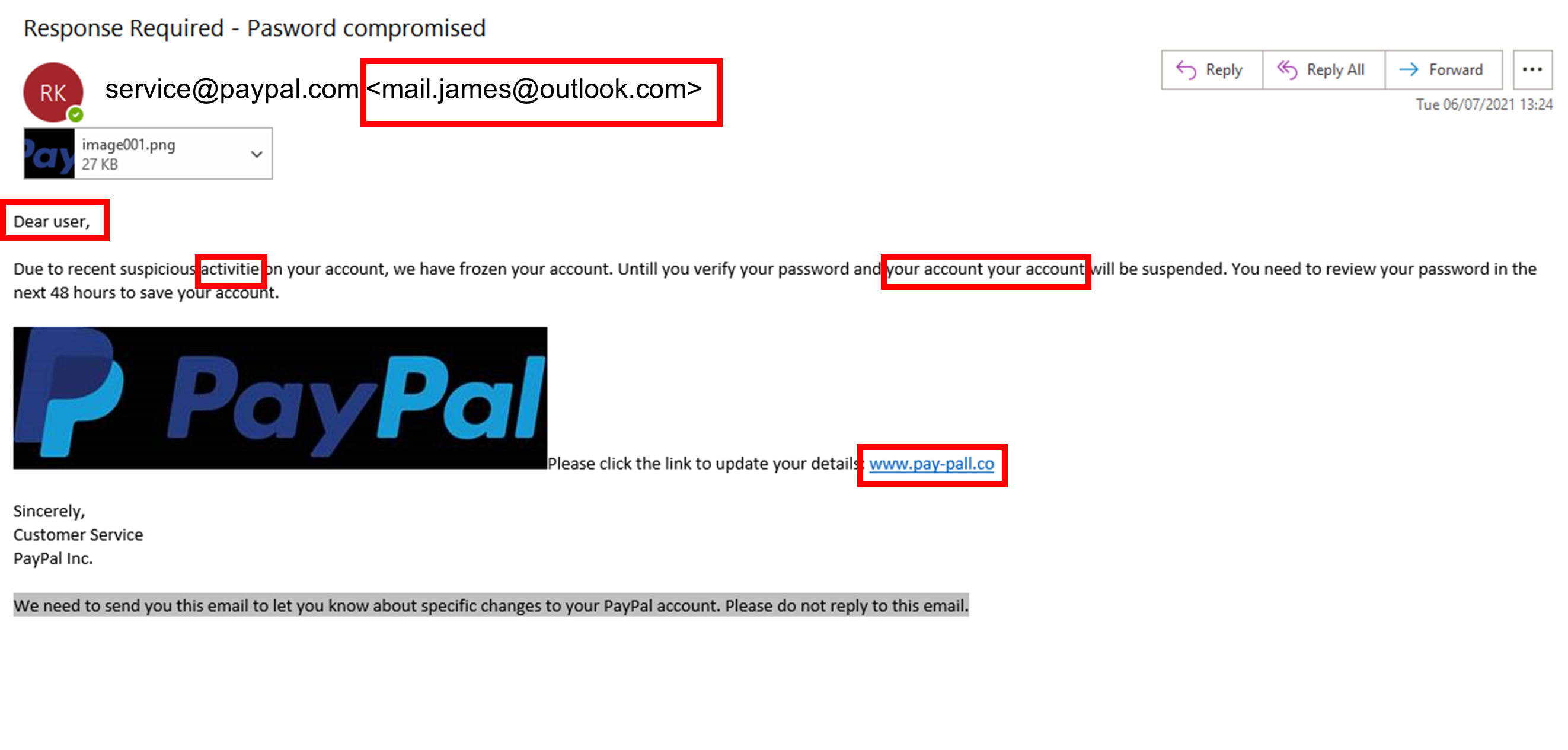
Tip 3: Track and Trace your Data
Keep Information on a Need to Know Basis
As stated before, your people are one of the biggest risks to your cyber security. Therefore, you should restrict access to certain documents and folders on your servers. By restricting access to these files, you ensure that your data does not fall into the wrong hands. This means that your employees cannot gain access to confidential information that does not relate to their job role. This is important as it limits the volume of information available to hackers in the event of a cyber-attack.
Track your Files and Servers
In addition to limiting access to certain files, ensure that you are tracking who accesses each document. This can provide you with insight into any potential data breaches. Using file auditing software allows you to monitor any unusual behavior in your internal systems. In the unfortunate event that you are victim of a cyber-attack, tracking your files can help you figure out which accounts have been breached. This will also help you to determine what information has been compromised.
Back Up your Data Regularly
Ensure that your data is backed up regularly. In the event of a cyber-attack, you will still have vital information that you need to continue with business as usual. Cloud-based solutions are the most efficient solution for this. These allow you to back up your data regularly and efficiently. Backing up your data also helps in the event of a systems failure.
Tip 4: Data Protection While Working from Home
With working from home (WFH) becoming the standard for a lot of organisations, it is important to understand the potential risks that come with this new style of working. Ensuring that you protect the privacy of your employees while they work at home is essential.
Firstly, you should ensure that your employees connect to your servers using a Virtual Private Network (VPN). This makes sure that their connection to the internet is secure. VPNs provide a more secure, encrypted connection for your employees, keeping your data safe. Also, make sure that confidential information is not being shared with other members of the household. Remember, information should be on a need-to-know basis.
Tip 5: Securely Dispose of your End-Of-Life IT
Protection from Cradle to Grave
The previous tips have looked at protecting data on your active IT equipment. However, it is equally important to ensure that your data is erased when you dispose of your IT equipment. Therefore, you must securely erase any traces of your data from your IT equipment at the end of its use. IT Asset Disposal companies, or ITADs, provide these services or you. ITADs will securely erase your data in one of two ways.
Firstly, using government-certified data erasure software known as Blancco, ITADs can securely wipe your data from a hard drive. This software erases every sector of your hard drive to ensure that all of your confidential information is removed.
Secondly, ITADs can shred your Hard Drives. Using government-approved hard drive shredders, ITADs are able to shred your data-bearing assets down to as little as a 6mm shred size. This makes it impossible for anyone to recover data from your old hard drive.
Why is Secure Data Erasure Important?
Although you may be finished with a laptop or PC, others may be interested in gathering the private information stored on them. Therefore, it is essential that all data is erased from a device. If residual data remains on a device, hackers could begin to piece this together. For example, one saved password on a laptop could compromise your entire future IT estate. Therefore, it is vital to your cyber security that you take care of your end-of-life IT assets.
Which ITAD should I use for Data Erasure?
When selecting which ITAD to use, there are several key aspects to consider:
- Accreditation – In order to ensure that your data is in safe hands, you should work with an ITAD which has the proper accreditation. Accreditations provide you with the peace of mind that an ITAD has been audited. This ensures that they are following the proper practices.
- Experience – By working with an ITAD with a long history in the industry, you ensure that your data is being cared for by experts. Firms with more experience in the industry will have more streamlined processes and better security for your data-bearing assets.
- Reporting – You should only trust ITADs which will provide you with a suite of reporting throughout the data erasure process. This provides you with evidence that your data has been erased fully. Without data sanitisation reports, you would not be able to prove that your data has been handled safely.
Re-Tek are one of the most accredited ITADs in the UK and are able to provide a solution to your IT asset disposal needs, no matter how big or small. With 25 years of expertise in the industry, Re-Tek will ensure that your data is handled securely and will provide you with a suite of reporting proving that all services have been carried out properly. To view the range of services Re-Tek offer, click here.
3 Key Arguments for Digital Product Passports
3 Key Arguments for Digital Product Passports - Are They the Future Industry Standard for the Circular Economy?
Digital Solutions are critical to the success of the circular economy. These solutions should be easily accessible for everyone, from original equipment manufacturers to final consumers. Could Digital Product Passports be the right solution for a more sustainable economy? Here are the key arguments for a Digital Product Passport.
What is a Digital Product Passport?
A Digital Product Passport (DPP) is a method of digitally recording information about a product. The main purpose of this is to provide an easy to access, centralized bank of information. The DPP’s information will depend on the product. In the IT sector, a DPP would give key information about the materials contained in the product, any repairs that have taken place, and information on how to recycle the product. In other sectors, information will differ. For example, a DPP for packaging will not have information about repairs, but will instead show the percentage of recycled material it contains.
Much of this information is already available. However, this would be a centralized location for all of the information required throughout the value chain. The idea of which is to move closer to a circular economy. Therefore, improved information flows would allow firms to improve their sustainable practices.
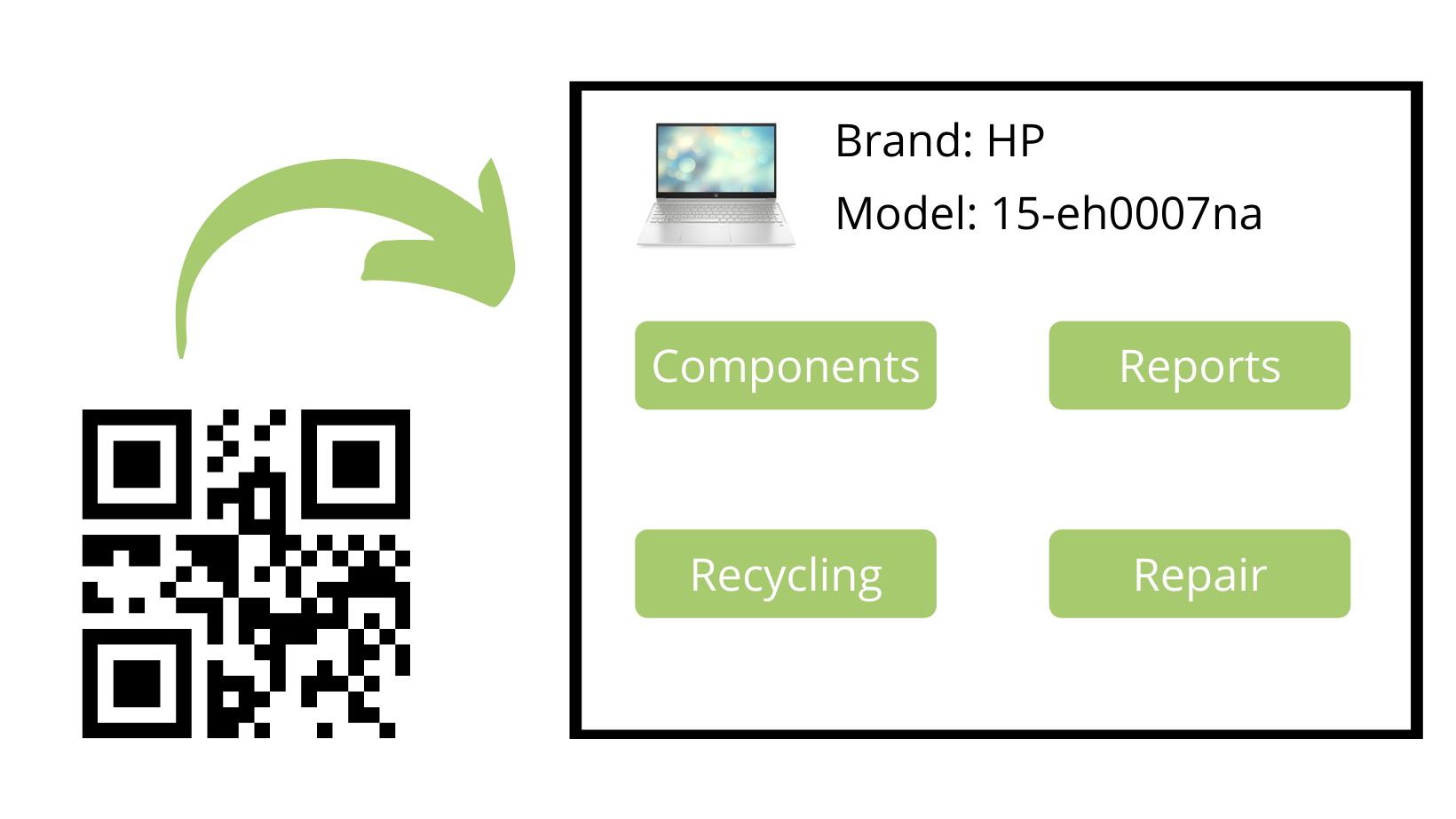
Why should we start using Digital Product Passports?
There are several key arguments for the integration of Digital Product Passports (DPPs) into our systems. These arguments detail benefits for different stakeholders throughout the value chain. From manufacturers to the final consumer, DPPs offer solutions which can help everyone to lower their carbon footprint.
Argument 1: Increased Transparency for both Consumers and Businesses
Currently, there is a lack of transparency surrounding the materials used in our products. This is because information regarding a product’s material is not always easily accessible. With the introduction of the ‘Right to Repair’ Directive, information about repairing your electrical goods has become more readily available. However, there is currently no standardized method for recording these repairs. Recyclers further down the value chain may not know about these changes currently. This becomes an issue where these components have different grades of materials. This will make waste streams more efficient as recyclers can easily separate waste into the correct channels.
Argument 2: Improved Sustainable Practices throughout a Product's Lifecycle
Digital Product Passports would play a key role in a more circular economy. This is mainly due to the increased availability of information for every member of the supply chain. But how does this help improve the sustainability of a product? There are several reasons for this:
Material Grades
Recyclers will be able to segregate waste more effectively thanks to an increase in information. This means that raw materials can be recycled based on their actual grades. Currently, there is a significant drop in quality when materials are recycled. This is because higher-grade materials are being recycled as a lower grade. This leads to an overall lower quality of recycled material for future use. Therefore, better reporting is key to improving the quality of recycled material used for future manufacturing. This would reduce the need for virgin raw materials. The material footprint of new products could be lowered by using recycled materials over virgin materials.
Understanding your Carbon Footprint
Digital Product Passports could allow you to better understand your product’s material footprint. For example, you would know how much of the product is made of recycled material. This can help you calculate the environmental impact of your business purchases. Additionally, a DPP could provide comparisons between new products and remanufactured products. This would allow you to calculate your carbon savings. Sustainability is critical to our future. Therefore, being able to quantify our environmental impact is a key consideration for most businesses.
Right to Repair
A Digital Product Passport would make repairing products easier. Repairers would be able to access key information about the components in a product. This will help them to find spare parts for repair. This is important in the IT sector, where components can differ very slightly. An integrated approach to information sharing would ensure that components are replaced properly. Additionally, any alternative components used in repair would be recorded. This would help recyclers sort the waste from the new components. Where repairs have been made during the lifecycle of a product, new components may have alternative materials to the original components. Overall, the implementation of a Digital Product Passport would be a step towards greater circularity in the economy.
Argument 3: Centralized Information Flow
There are currently several information flows required by the government for different products. These include WEEE reporting and energy efficiency ratings. A Digital Product Passport would provide a one-stop shop for all of this information. This would benefit members of every stage of the supply chain. For manufacturers, it would provide a single solution to their initial reporting. Therefore, manufacturers would be able to enter all of the information into one central system. For end users, it provides an easily accessible platform for any issues during the lifecycle of a product. For example, it would provide information for repairs should a problem arise. It would also provide a centralized solution to their environmental reporting. For recyclers, it makes environmental reporting simpler. This would standardize procedures which would benefit all members of the value chain.
Avoid Losing Data
According to David Fitzsimons, director of the European Remanufacturing Council, data loss is one of the biggest threats to the circular economy. After-sales processes can be improved by improving the flow of information,. This is because processes further down the value chain can become more efficient. All of this could be done through a Digital Product Passport.
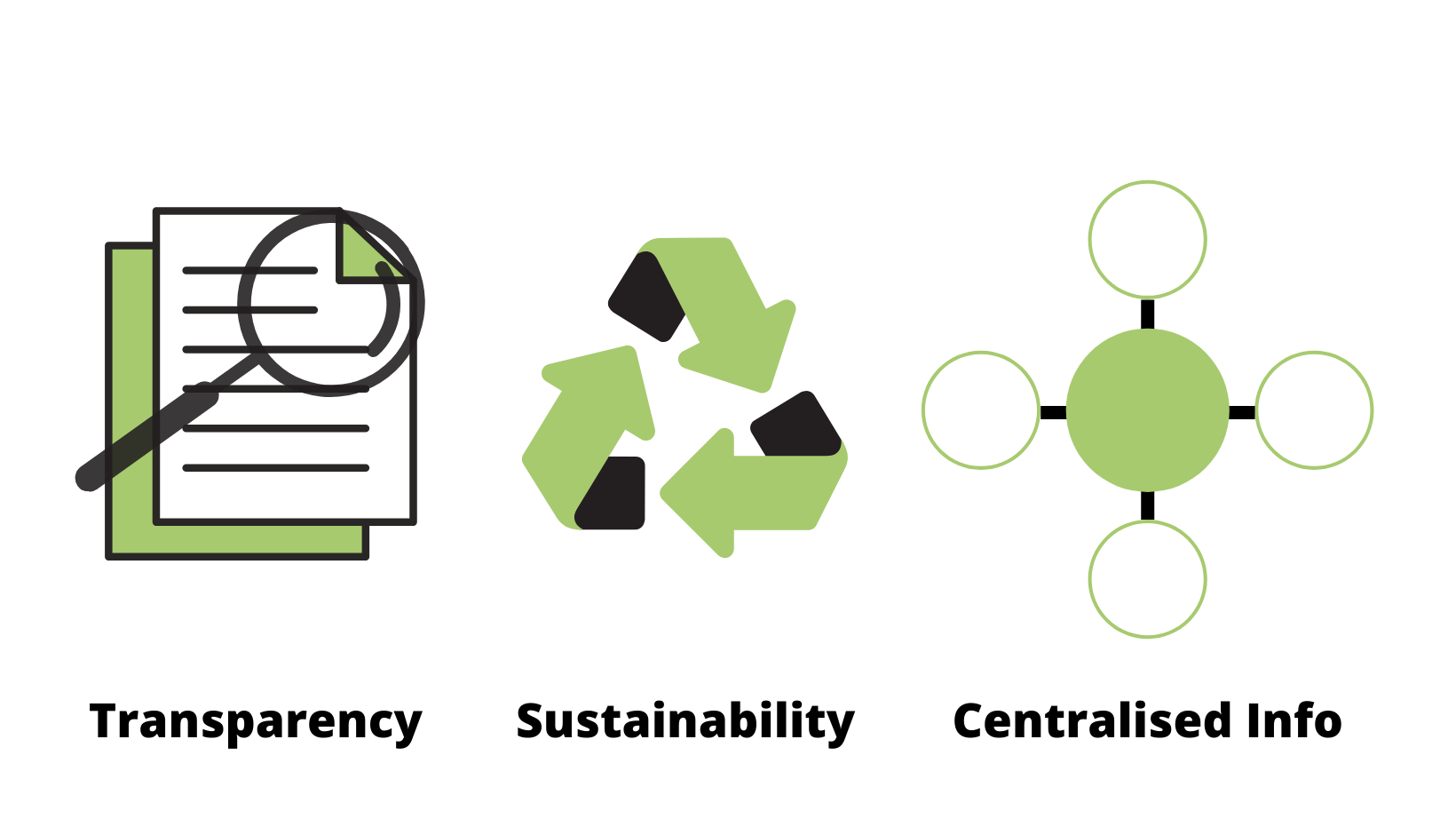
How Would each Member of the Supply Chain Benefit from a Digital Product Passport?
The Digital Product Passport’s success relies on the benefits that it gives to every stakeholder. Therefore, the benefits must be clear for each stakeholder. Otherwise, it will not be possible to integrate a DPP into the lifecycle of our products. But how would a digital passport benefit each of these stakeholders?
Manufacturers
For the manufacturer, the Digital Product Passport allows them to provide their information in a centralized file. This would aid them in limiting the number of documents that they need to complete in the future. Additionally, a DPP could help manufacturers to better understand the material footprint of their products. In doing so, manufacturers could better understand their product’s lifecycle. This would allow them to make changes that could improve the sustainability of their products. For those who produce environmentally sound products already, this would provide a credible channel for them to make claims about their sustainability. A DPP would give them a competitive advantage, as they would have proof of the sustainability of their products. This method of reporting would differentiate them from other companies who attempt to green-wash their brands.
Repairers
Having an easier means of accessing information about products will primarily benefit repairers. The Digital Product Passport will hold valuable information about the materials and components of a product. For repairers, this will decrease the amount of time taken to seek out replacement parts. This will help repairers to increase the value of their service as information about repairs becomes more readily available. This lines up with the ‘Right to Repair’ Directive, which promotes repair over recycling where possible. As end users become more aware of the carbon footprint of their devices, there will likely be an increased demand for repair in the future.
Recyclers
The benefits for end-of-life handling are clear. With information more readily accessible, recyclers will be better equipped to recover valuable materials from end-of-life products. These services are essential to the circular economy. Recyclers will also benefit from a centralized file for any environmental reporting. Currently, recyclers could have several different reports to complete when carrying out their processes, including WEEE reporting or data destruction certificates.
End Users
The end user benefits from an increase in transparency. This allows them to make more sustainable purchase decisions. This is because they are able to see the material footprint of a product prior to purchasing it. Additionally, an increase in information gives them the opportunity to think circular. This means they are more aware of the repair services available to them, as well as the importance of properly treating end-of-life products.
How Should a Digital Product Passport Work?
For a Digital Product Passport to work and deliver the value that is required, it would need to be easy to access. This is so that users can find information quickly and efficiently. This information should be provided through QR codes where both consumers and businesses can quickly access the information required for repairs or for recycling processes.
The information needs to be at two different levels: One level for consumers which is easy to digest and with the key information about replacement parts and warranty information. On the other hand, another level of information for businesses the materials used in the product is required.
Is the Circular Economy the Solution to Climate Change
Our Current Situation
The climate crisis is an ever-looming threat to our society and tackling climate change has become a global priority. The UN has now set key Sustainable Development Goals while the UK government have set out a 25-year climate change plan. Developing more sustainable life-cycle management for our products has therefore become a key concern as material management is expected to account for two thirds of all greenhouse gas emissions by 2060 if we continue with current manufacturing and waste management practices[1]. Sustainable Development Goal 12 focuses on sustainable production and re-manufacturing.
According to recent studies, manufacturing processes currently account for over 45% of all greenhouse gas emissions worldwide[2]. This colossal figure encompasses every stage of the manufacturing process, from the energy used in natural resource mining to the carbon emissions of industrial factories. However, the circular economy offers a key solution for tackling these emissions. By re-using materials which are already in the economy, through refurbishment and re-manufacturing practices, the carbon footprint from manufacturing can be cut in half. This is because these processes preserve what is known as ‘embedded energy’. This is the energy that was required for the initial manufacturing process. By reusing these components, we are able to avoid the emissions required to manufacture from scratch. Therefore, the material footprint of refurbished products is much lower than of new products.
The environmental savings from reducing the material footprint by reusing and recycling products are expected to total 1.1 billion tonnes of CO2 per year[3]. Thus, prioritising the circular economy is the quickest and easiest way to cut greenhouse gas emissions from manufacturing. An investment in the circular economy does not only benefit the environment, but also has significant economic outcomes as well. The economic benefits of a more circular economy are evident, with current estimations finding that an increase in the use of refurbishment and recycling processes would result in £57.3 billion being added to the UK’s GDP while creating 330,000 jobs within the sector[4].
Why does WEEE Recycling Matter?
The UK has a growing mountain of electronic and electrical waste which it needs to tackle to effectively lower its carbon footprint. Currently, waste electronics and electrical equipment (WEEE) is one of the fastest growing waste streams in Europe and is therefore a key priority in the UK. Electronic waste has grown 38% worldwide from 2010 to 2019 with little being done to curb this growth[5]. This means that the material footprint of the electrical manufacturing industry is quickly snowballing into a much bigger problem. It is therefore the responsibility of both businesses and consumers alike to shrink the material footprint of their electrical purchases. It is imperative that we all participate in the circular economy, through structured, efficient waste management streams.
Ultimately, the circular economy is an effective short-term solution to the climate crisis, but it is not enough to fully eradicate the current climate crisis. However, by taking greater care throughout the life-cycle of our electronics and electrical products, from initial manufacturing to end-of-life disposal, the carbon footprint of these products can be dramatically lowered.
Re-Tek are able to refurbish over 90% of the equipment that we receive and almost everything that we cannot refurbish is recycled in line with the WEEE recycling directive, with less than 1% of materials going to landfill. Powered by a 50kW solar panel array as well as a 60kW biomass boiler, Re-Tek are able to drastically lower the carbon footprint of waste electronics and electrical equipment (WEEE) while providing financial incentives to our partners.
[1] OECD – The Circular Economy in Towns and Cities
[2] Ellen MacArthur Foundation -How the Circular Economy Tackles Climate Change
[4] WRAP – Net Zero: Why Resource Efficiency Holds the Answers
Re-Tek Achieve CAS(S) Certification

As you may have seen already on the Re-Tek UK LinkedIn page, Re-Tek UK are now a CAS(S) approved service provider. Even after 25 years, we still strive to improve our business in order to provide you with the best and most secure service possible. This certification is a testament to the tremendous effort of our staff who maintain the highest standards of security every day. We understand that some of you may not know what this certification is or what it means for you as a customer, therefore we have compiled some information about our latest accreditation to answer some of your questions.
What is the CAS(S) certification?
The CAS(S) certification ensures that any accredited service provider conforms to the high standards set by the National Centre for Cyber Security, a government department dedicated to setting best practices for cyber protection. This certification means that Re-Tek are now certified to destroy data safely and securely up to and including the Government’s ‘official’ level.
How were Re-Tek assessed for this certification?
A representative for the National Cyber Security Centre assessed Re-Tek’s services and procedures in order to ensure that we met their standards. Namely, Re-Tek were assessed to ensure that all data-bearing assets were kept secure both during transportation and while in storage. Additionally, Re-Tek’s equipment was evaluated to ensure that it is properly maintained and that we follow the correct data sanitisation processes at all times. Finally, Re-Tek were assessed to ensure that all of our processes are audited internally to ensure that we continue to improve our service offering in the future.
What does this mean for you as a customer?
First and foremost, it means that you can feel assured knowing that all of the data-bearing assets you send to us will be treated by a team of trained staff. Secondly, you can be certain that all of your private data will be securely destroyed and that you will get asset reports which show that all processes have been carried out correctly. Finally, you know that you are working with one of the leaders of the IT asset disposal market as Re-Tek are the first company based in Scotland to achieve this certification.
What does this mean for Re-Tek?
Receiving this certification was one of our main goals for this financial year. Achieving this milestone reminds us that we must always strive to improve our service offering in order to achieve new heights. For now, our focus is firmly on ensuring that we maintain the standards of service that you as customers expect and that you receive the support and service that you deserve.
To find out more about our newly accredited services, please visit our Services Page.
